
|
Sale 137
Pre-Long Beach Auction
| Lot |
Photo |
Description |
Realized |
Lot 1159 |
 |
Great Britain. Pattern Sovereign, 1838. WR-300. DM-202 (same coin?). By William Wyon. Victoria, 1837-1901. Plain edge. Large young head left. Reverse: Crowned shield within filleted laurel wreath; rose, shamrock and thistle spray below. Same as normal dies but for an extra curl of hair before Victoria's ear. "W.W." raised on truncation. Digit "3" broken at bottom of curve: the entire date appears larger than on DM-201. Dies inverted. R4, very rare (11 to 20 known), a choice specimen with lovely red iridescence. Pop 1; The only one graded at NGC. NGC graded Proof 63 Ultra Cameo. Estimated Value $40,000 - UP
Ex Dr Jacob Y. Terner Collection; Ex Goldberg 'Millennia' Sale, 46, May 26, 2008, lot 445.
View details and enlarged photos
Realized
$39,600 |
|
Lot 1160 |
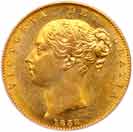 |
Great Britain. Sovereign, 1838. S.3852; Fr-387. Victoria. Young bust of Queen left. Reverse; Shield within wreath. A very high grade example of this rare early date. Pop 7; 35 finer at PCGS. PCGS graded MS-61. Estimated Value $2,500 - UP
Ex Goldberg Sale, 34, Feb 5, 2006, lot 2285.
View details and enlarged photos
Realized
$6,000 |
|
Lot 1161 |
 |
Great Britain. Coronation Gold Medal, 1838. Eimer-1315; BHM-1801. 30.76g. 36 mm. Plain edge. By B. Pistrucci. Victoria, 1837-1901. Obv. Head left, draped and wearing a bandeau, VICTORIA D G BRITANNIARUM REGINA F D. Reverse; Victoria enthroned left, receives a crown from Britannia, Hibernia and Scotia, ERIMUS TIBI NOBILE REGUM, three lines in exergue, INAUGURATA / DIE JUNII XXVIII / MDCCCXXXVIII. PCGS graded Uncirculated Detail (Devices Engraved). Estimated Value $2,500 - UP
Ex St. James's Auction 2, May 11, 2005, lot 433.
View details and enlarged photos
Unsold |
|
Lot 1162 |
 |
Great Britain. Gold Pattern "Una and Lion" Five Pounds, 1839. By William Wyon. W&R-277 (R6); S-3851 (third piece listed, extremely rare). Ornate deeply toothed border on both sides. Plain edge. Obv. Young filleted head left, front fillet with five full scrolls, rear fillet plain, W. WYON.RA in relief on truncation, VICTORIA D:G: BRITANNIARUM REGINA F:D: legend. Reverse: the Queen as Una leading the British lion, plain left shoulder (no Garter Star), scepter extended in right hand, orb in left hand, above DIRIGIT DEUS GRESSUS MEOS. Date in roman numerals in exergue MDCCCXXXIX. above W WYON R.A. Struck en medaille. Exceedingly Rare. Pop 1. PCGS graded Proof 62 Deep Cameo. Estimated Value $200,000 - UP
This is an exquisite rarity, similar to the pieces issued in the 300 Proof Sets of 1839 but an early pattern made before the design was finalized-the prototype. It is similar to W&R-276 which has an edge legend in large raised letters and is R7 (1-2 known). No more than 5 pieces were made or are known of this. The cataloguer (BL) has never seen this pattern before (aside from its appearances in the noted auctions) in 45+ years of involvement in British coins. Most distinctive on this pattern is the bold rim on each side, which was abandoned for the final issue as being perhaps too distracting. In truth it provides the coin with a dramatic frame. Desite its modest grade of PR62, this is a coin of superb appearance in hand, and in fact such a rarity as to be a national treasure. It deserves a lasting home in a great collection!
Ex Baldwin Auction 17, 5 May 1998, lot 714; Spink, London, May 5, 2005, lot 210.
View details and enlarged photos
Realized
$552,000 |
|
Lot 1163 |
 |
Great Britain. Proof 'Una & Lion' Gold Five Pounds, 1839. S.3851; WR-279; Fr-386; KM-742. Lettered Edge. Five Scrolls. Victoria, 1837-1901. Young Head. Produced by the great 19th-century coin engraver William Wyon, this is among the most famous and desirable of British coins. The obverse design features a young bust of Victoria aged 20 years, while the reverse has the Queen dressed as Una leading the British lion. This gorgeous specimen is remarkably free from scuffs that other examples of this rare coin fall victim to, and the cameo effect of the detailed design is unusual. Pop 3; 3 in 64 DCAM. PCGS graded Proof 63+ Deep Cameo. Estimated Value $150,000 - UP
The 1830s was the last decade of the Romantic Age in England. It was a time when the public's mind was captivated by daring adventurers like Lord Byron whose escapades were celebrated in newspapers and books-and in extremely popular poems. Millions of citizens had also read or had been told about classic stories in school. One of the most popular was the Elizabethan epic poem by Edmund Spenser called The Faerie Queene. It told the tale of a valiant young woman who wandered the kingdom portected by her personal knight. It had captivated readers for generations. When Victoria inherited the British throne from her uncle in 1837, she reminded people of Una in Spenser's story-young, innocent, untried and majestic.
William Wyon, the gifted young stylist of coin designs at the Royal Mint in London, engraved a sensitive portrait of Victoria, called the Young Head by collectors, which appeared on all of her early coins. Whenhe combined it with his design depicting the allegorical Una from the poem, guiding the British lion with her scepter, it seemed to many that Victoria was destined to lead the nation to greatness. The design appeared only on the largest gold coin in Victoria's Coronation Proof set of 1839. A beautiful coin, it seemed to inspire loyalty while capturing the spirit of those adventurers. The Latin legend appealing to God to guide Victoria's steps became reality as the decades of her reign passed, for the empire reached its peak near the end of Victoria's rule. Inspired by the story of an earlier time, designer William Wyon created an indelible image for the ages-a coin cherished by collectors worldwide.
Ex Goldberg Sale 37, Sept 2006, lot 3724.
View details and enlarged photos
Realized
$336,000 |
|
Lot 1164 |
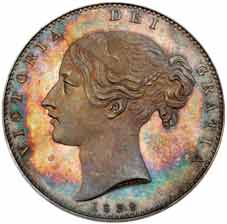 |
Great Britain. Silver Pattern Crown, 1839. Linecar & Stone-36; ESC-2649 (332) Rarity 7. In silver on a thin flan weighing 21.19g. By W. Wyon. Victoria, 1837-1901. Young head left, W WYON.RA on truncation, date below. Reverse; DIRIGE DEUS GRESSUS MEOS., Una and the Lion, date in roman numerals and W.WYON R.A. in exergue, edge inscription DECUS ET TUTAMEN ANNO REGNI TERTIO. Beautiful irisdescent tone. Excessively rare, this believed to be only the second recorded specimen. The other known example is the Whetmore/Murdoch/Montagu/Pendlebury specimen. PCGS graded Proof 63. Estimated Value $50,000 - UP
Portrait of the young Victoria without crown, her hair bound by two "fillets" and tied in a pony-tail, with her name and "By the grace of God" in Latin surrounding. The beautiful reverse design was inspired by a classic poem that remained popular for two and a half centuries in Great Britain-Edmund Spenser's The Faerie Queene. A long tale of great complication, it was about a mythic being simply named Una, which meant "One" and stood for the first and greatest godly value-truth. Early in the story of the Faerie Queen, while metaphorically wandering around the kingdom of King Arthur, Una encounters a lion. Instead of fiercely attacking her, the lion caresses her and immediately becomes her companion, guarding her and leading the way on her journey. She ends up in Eden.
The Royal Mint's William Wyon translated this story into the dramatic image seen on this coin's reverse. The large central motif is surrounded by a legend in Latin translating to mean "May God Guide My Steps" (some would say "footsteps") with the date 1839 beneath in roman numerals and the "signature" of the Royal Mint's engraver William Wyon, RA (standing for Royal Academy). While it is hard to believe today, in 1839 this design was controversial at the mint, whose officers felt that, despite its obvious beauty, the image was of such high relief that it would not strike up consistently as a coin for commerce. This was the essential reason for the existence of patterns or "off strikes" in other metals-to test the dies. The decision was reached to strike the coin only in proof state and in gold for Victoria's Coronation Proof Set of 1839. For the set, some 300 coins were minted initially, although restrikes continued for years in response to collector demand. By contrast, this pattern is of extreme rarity: just 3-5 are known in silver.
Ex Baldwin's Auction 42, Sept 26, 2005, lot 1163.
View details and enlarged photos
Realized
$408,000 |
|
Lot 1165 |
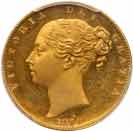 |
Great Britain. Proof Sovereign, 1839. S.3852; WR-303; KM-736.1. Plain Edge. Coin Alignment. Victoria, 1837-1901. First Young head left. Reverse; Crowned quartered shield of arms, date below. Issued in the Coronation set of this year. Pop 2; 1 in 65DCam. This coin photo in the PCGS Pop Report. PCGS graded Proof 64 Deep Cameo. Estimated Value $20,000 - UP
Ex Spink, London, May 2005.
View details and enlarged photos
Realized
$33,600 |
|
Lot 1166 |
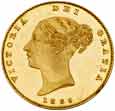 |
Great Britain. Proof Half Sovereign, 1839. S-3859; Fr-389A; KM-735.1; W&R-344 (R3). Plain edge. Struck in 'en medaille'. Victoria, 1837-1901. Issued in the Coronation set of this year. Victoria. First Young head left. Reverse; Crowned shield within filleted laurel wreath; rose, shamrock and thistle spray below. Rare. Pop 7; 10 Finer at PCGS. PCGS graded Proof 63 Deep Cameo. Estimated Value $4,000 - UP
Ex Baldwin St. James's Auction 2, Nov 5, 2005, lot 645.
View details and enlarged photos
Realized
$9,900 |
|
Lot 1167 |
 |
Great Britain. Proof Crown, 1839. S-3882; Dav-105; KM-741. Plain edge. Victoria, 1837-1901. Young head left. Reverse; Crowned arms within wreath. Issued in coronation set. Deep blue and gold iridescent toning. Pop 3; 1 in 64+; 1 in 65. This coin photo in the PCGS Pop Report. PCGS graded Proof 64. Estimated Value $20,000 - UP
Ex Spink, London, May 2005.
View details and enlarged photos
Realized
$42,000 |
|
Lot 1168 |
 |
Great Britain. Proof Halfcrown, 1839. S.3885; ESC-670; KM-740. Plain Edge. Victoria, 1837-1901. Young head left. Reverse; Crowned arms within wreath. Issued in coronation set. Deep blue and gold iridescent toning. Pop 7; 4 in 65. This coin photo in the PCGS Pop Report. PCGS graded Proof 64. Estimated Value $4,000 - UP
Ex Spink, London, May 2005.
View details and enlarged photos
Realized
$10,200 |
|
Lot 1169 |
 |
Great Britain. Gold Medal, 1842. BHM-2070; Eimer-, 1.6g, 16 mm. Victoria, 1837-1901. Gold Extracted from Silver Captured in the First Opium War. London mint. Dually dated 1829 and March 1842. Crown, leg:THIS GOLD/ DISCOVERED IN/ SYCEE SILVER/ THE PRIZE OF BRITISH/ ARMS IN CHINA/ WAS EXTRACTED/ AT H.M. MINT/ MARCH/ 1842 in nine lines. Reverse; leg: THE R.T HON/ W. GLADSTONE/ MASTER/ BY A PROCESS FIRST/ APPLIED TO THE PUBLIC/ SERVICE AND TO THE/ BENEFIT OF BRITISH/ COMMERCE UNDER/ THE R.T HON./ J.C. HERRIES/ 1829 in eleven lines. Rare. Pop 1; The only Example graded at PCGS. PCGS graded Specimen 63. Estimated Value $3,000 - UP
Ex Anthony Tan, private treaty, Aug 2004.
View details and enlarged photos
Realized
$7,500 |
|
Lot 1170 |
 |
Great Britain. Half Sovereign, 1850. S-3859; Fr-389B; KM-735.1; Marsh-424. Victoria, 1837-1901. Among the finest known. Pop 1; 1 in 65; 1 in 65+. PCGS graded MS-64. Estimated Value $2,500 - UP
Ex Baldwin St. James's Auction 2, Nov 5, 2005, lot 647.
View details and enlarged photos
Realized
$2,340 |
|
Lot 1171 |
 |
Great Britain. Gold Pattern Quarter Sovereign, 1853. W&R-365 (R4) 12-20 known; Douglas-Morris-186; KM-PN-113. 2.01g. Plain edge. By William Wyon. Victoria, 1837-1901. Obv. Small young head left, VICTORIA D:G: BRITANNIAR: REGINA F:D:, toothed border both sides. Reverse; Struck en medaille, crowned quartered shield of arms dividing date, QUARTER above SOVEREIGN below. Extremely Rare. Pop 1; The only Example graded at PCGS. PCGS graded Specimen 63. Estimated Value $10,000 - UP
According to the research article, "Quarter-Sovereigns and Other Small Gold Patterns of the Mid-Victorian Period" by G. P. Dyer (curator of the Royal Mint), in the British Numismatic Journal for 1997, page 77: all of these have plain edges; mintage not certain, but only 12 were known by 1854.
Ex Spink, London, May 5, 2005, lot 214.
View details and enlarged photos
Realized
$22,800 |
|
Lot 1172 |
 |
Great Britain. Gold Pattern Ducat, 1867. W&R-388 (R4); Murdock-517. 3.29g. Plain edge. By Leonard C. Wyon. Victoria, 1837-1901. Obv. Coroneted head left, VICTORIA D:G: BRITANNIAR: REG: F:D:, toothed border both sides. Reverse; Struck en medaille, ONE DUCAT within oak wreath, ONE HUNDRED PENCE above, date below, rosette either side. Extremely Rare. Pop 1; The only Example graded at PCGS. PCGS graded Proof 65 Cameo. Estimated Value $7,500 - UP
"This very rare ducat was struck after the first International Monetary Conference, held in Paris in 1867. The initiative proposed at this assembly was the adoption of a single gold standard, decimalisation and overall international coordination of various currencies. Hence the present gold piece, bearing the dual denominations of 'DUCAT' and 'ONE HUNDRED PENCE', meeting all three of the Conference's criteria. Due to the difficulties concerned with the pegging of international currencies and the relative values of gold, these initiatives never entered circulation".
Ex Spink, London, May 5, 2005, lot 211.
View details and enlarged photos
Realized
$37,200 |
|
Lot 1173 |
 |
Great Britain. Gold Pattern Double Florin, 1868. W&R-372 (R4); Douglas-Morris-185. 1.64g. Plain edge. By William Wyon. Victoria, 1837-1901. Obv. Coroneted head left, VICTORIA D:G: BRITANNIAR: REG: F:D:, toothed border both sides. Reverse; Struck en medaille, DOUBLE FLORIN 1868 in three lines within oak wreath, 5 FRANCS INTERNATIONAL surrounding. Extremely Rare. The PCGS ID# shows 520783; However the Pop Report shows #651836. PCGS shows Pop: 1-63; 1-65. Our coin is the Finest graded at PCGS. PCGS graded Proof 65+ Cameo. Estimated Value $10,000 - UP
This superb pattern was originally issued in a red leather plush presentation case measuring 67x40 mm, 17 mm thick, inscribed "PATTERN DOUBLE FLORIN. 1868." in gilt letters and digits on top, with a scribed rectangular gilt line surrounding. The interior "seat" for the coins was in blue velvet. Light-colored silk covers the interior top. The designs were identical other than the edge style-one plain, the other reeded. The pieces were engraved by William Wyon. Why were they made? During the late 1860s into the middle 1870s, various European governments, as well as the United States, assembled committees to consider ways to promote and facilitate international trade among themselves. France issued a neat, small gold coin called 5 Francs. The United States already minted its gold dollar and its $5 gold piece, two coins which competed perfectly with the British gold Sovereign. The U.S., however, also contracted with design artists to create other denominations that might be used for this purpose, most of which never proceeded beyond initial consideration and/or a handful of pattern strikes. Great Britain tasked the grand old master engraver William Wyon to design and cut dies for this "Double-Florin" in gold, clearly stating its purpose on the reverse and giving the equivalent value of 5 Francs "International" in the encircling legend. The U.S. gold dollar was of exactly the same value. This pair of patterns never advanced to being issued, leaving collectors today with these diminutive jewels in gold-ideal pieces to add to any collection of Victoria's coinage or of gold proofs.
Ex Spink, London, May 5, 2005, lot 213.
View details and enlarged photos
Realized
$40,800 |
|
Lot 1174 |
 |
Great Britain. Five Pounds, 1887. Fr-390; S.3864. Victoria. Jublilee head left. Reverse; St George slaying the dragon. Sparkling mint luster, good eye-appeal. PCGS graded MS-63. Estimated Value $5,000 - UP
Ex Goldberg Sale, 34, Feb 5, 2006, lot 2295.
View details and enlarged photos
Realized
$9,000 |
|
Lot 1175 |
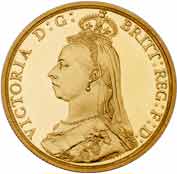 |
Great Britain. Proof Two Pounds, 1887. S-3865; Fr-391a; KM-768. Victoria, 1837-1901. Victoria Jubilee Head. Crowned and veiled older bust left. Reverse: St George and the Dragon, date below. A really choice example, with brilliant mirrors and delightful cameo contrast. Pop 19; 27 Finer at PCGS. PCGS graded Proof 63 Deep Cameo. Estimated Value $6,000 - UP
The entire mintage was a mere 797 pieces, minted for inclusion in the collector sets commemorating Victoria's jubilee year -- her fiftieth year on the throne.
Ex Baldwin St. James's Auction 2, Nov 5, 2005, lot 424.
View details and enlarged photos
Realized
$8,400 |
|
Lot 1176 |
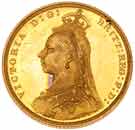 |
Great Britain. Proof Sovereign, 1887. S.3866B; Fr-392a; KM-767. Victoria, 1837-1901. Crowned jubilee head left. Reverse; St. George and the dragon. From the proof set from the year of the Queen's Jubilee. Pop 10; 54 Finer at PCGS. PCGS graded Proof 62 Deep Cameo. Estimated Value $2,500 - UP
Ex Baldwin St. James's Auction 2, Nov 5, 2005, lot 663.
View details and enlarged photos
Realized
$4,080 |
|
Lot 1177 |
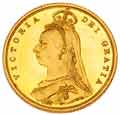 |
Great Britain. Proof Half Sovereign, 1887. S.3869; WR-362; Fr-393a; KM-766. Victoria, 1837-1901. Crowned jubilee head left. Reverse; Crowned shield of arms. From a mintage of a mere 797 pieces. A fantastic example from the proof set from the year of the Queen's Jubilee. Pop 6; 3 in 66; 1 in 66+; 1 in 67. PCGS graded Proof 65 Deep Cameo. Estimated Value $3,000 - UP
Ex Baldwin St. James's Auction 2, Nov 5, 2005, lot 664.
View details and enlarged photos
Realized
$5,760 |
|
Lot 1178 |
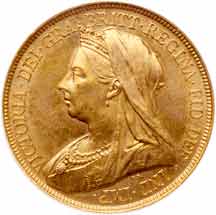 |
Great Britain. Five Pounds, 1893. S-3872; Fr-394; KM-787. Victoria, 1837-1901. Old Head Coinage. Veiled, draped and crowned old bust left. Reverse; St. George and the Dragon, date below. Pop 19; 1 in 63+; 13 in 64. PCGS graded MS-63. Estimated Value $3,500 - UP
Ex St. James's Auction 2, May 11, 2005, lot 431.
View details and enlarged photos
Realized
$16,800 |
|
Lot 1179 |
 |
Great Britain. Coronation Matte Proof Gold Set, 5 & 2 Pounds, Sovereign & ½ Sovereign, 1902. Fr-398a-401a; KM-804-807. Edward VII, 1901-1910. PCGS graded Half Sovereign, Matte Proof 63; PCGS graded Sovereign, Matte Proof 63; PCGS graded 2 Pounds, Matte Proof 63; PCGS graded 5 Pounds, Matte Proof 62. Lot of 4 coins. Estimated Value $6,000 - UP
Ex Baldwin's Auction 2, May 2005, lot 520 (part).
View details and enlarged photos
Realized
$9,300 |
|
Lot 1180 |
 |
Great Britain. Proof Five Pounds, 1911. S.3994; Fr-402; KM-822; WR-414. George V. Mintage 2,812 pieces struck. One year type coin made especially for the Coronation set. Featuring bare head of King left. Reverse; St. George and the dragon. Pop 41; 1 in 64+; 18 in 65; 6 in 66. PCGS graded Proof 64. Estimated Value $12,500 - UP
Ex St. James's Auction 2, May 11, 2005, lot 536.
View details and enlarged photos
Realized
$17,400 |
|
Lot 1181 |
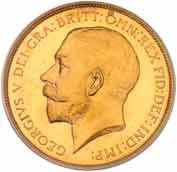 |
Great Britain. Proof Two Pounds, 1911. S.3995; Fr-403; KM-821. George V. Bare head left. Reverse; St. George and the dragon. From the Coronation set of this year. Pop 32; 41 Better at PCGS. PCGS graded Proof 64 Cameo. Estimated Value $2,500 - UP
Ex St. James's Auction 2, May 11, 2005, lot 537.
View details and enlarged photos
Realized
$4,560 |
|
Lot 1182 |
 |
Great Britain. Trade Dollar, 1921-B. KM-T5; Prid-24. KM catalog indicates a mintage of only 5 pieces struck. Light toned, possibly the finest known, Extremely Rare. Pop 2; None Finer at PCGS. Only 4 graded in total at PCGS. This coin photo in the PCGS Pop Report. PCGS graded MS-63+. Estimated Value $25,000 - UP
Ex Spink, London, April 15, 2004, lot 500; Noble Numismatics, No.48, 11-13 July 1995, lot 3310; Money Company, Hong Kong, 6-7 September 1985, lot 936.
View details and enlarged photos
Realized
$93,000 |
|
Lot 1183 |
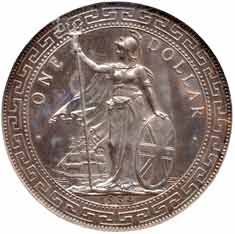 |
Great Britain. Proof Trade Dollar, 1934-B. KM-Tn5. Reported mintage of only 20 pieces struck. Beautiful deep iridescent toning on both sides. Very Rare. Proof 65 Primium Quality. sure looks at least Proof 66. Pop 1; The only one graded in proof at NGC. NGC graded Proof 65. Estimated Value $10,000 - UP
The word "dollar" entered the English language by route of Scotland, of all places. Between 1567 and 1571, King James VI struck two types of large silver coins, which were known as the "Sword Dollar" and the "Thistle Dollar" locally. The Scots preferred the term "dollar" to distinguish themselves and their money from their domineering, and territorially grasping, neighbor to the south, the English. Thus from an early date the use of the dollar carried with it a certain nationalistic, anti-English connotation. The extensive emigration of Scottish settlers to both the New and Old World colonies may well account for the ready acceptance and popularity of the word in British colonies around the world. The British trade dollar competed in Asia with the American, Mexican and other silver coins of this approximate size for many years, as silver was traditionally preferred over gold by Chinese and other mechants and bankers. The end was near in 1934, when this coin was created, for in 1935 the law was changed in Hong Kong, causing almost all 1935 and countless recent trade dollar coins to be melted, and to disappear from circulation. This is an historically significant, and extremely rare, specimen.
Ex Irving Goodman Collection; Illustrated in Money of The World, coin 140; Ex Goldberg 'Millennia' Sale, 46, May 26, 2008, lot 471.
View details and enlarged photos
Realized
$36,000 |
|
Lot 1184 |
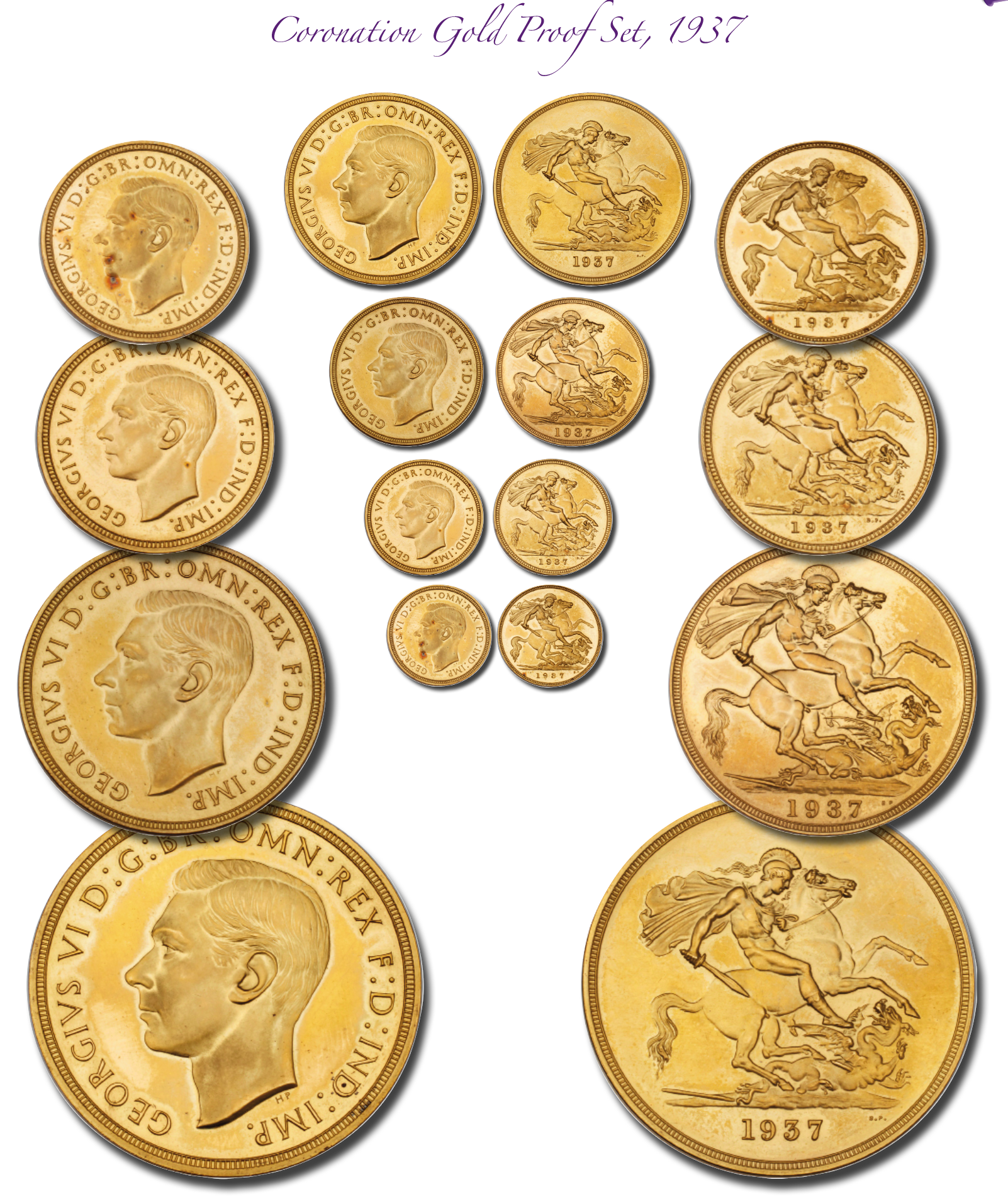 |
Great Britain. Coronation Gold Set: 5 and 2 Pounds, Sovereign and Half Sovereign, 1937. Fr-409-412; KM-21; S.PS15. George VI, 1936-1952. Half Sovereign PCGS graded PR64 Cameo; Sovereign PCGS graded PR63 Cameo; Two Pounds PCGS graded PR64 Cameo; Five Pounds PCGS graded PR63 Cameo. Lot of 4 coins. Estimated Value $10,000 - UP
Ex St. James's Auction 2, May 11, 2005, lot 559.
View details and enlarged photos
Realized
$15,600 |
|
Lot 1185 |
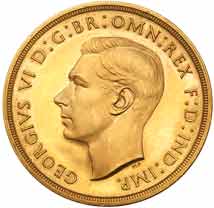 |
Great Britain. Proof Five Pounds, 1937. S.4074; Fr-409; KM-861. Struck for the Coronation of George VI. Head of King left. Reverse; St. George and the Dragon. One year type. Pop 66; 39 Finer at PCGS. PCGS graded Proof 64 Cameo. Estimated Value $7,500 - UP
Ex St. James's Auction 2, May 11, 2005, lot 560.
View details and enlarged photos
Realized
$11,400 |
|
Lot 1186 |
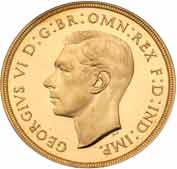 |
Great Britain. Proof Two Pounds, 1937. S.4075; Fr-410; KM-860. George VI. Obverse Paget's portrait of king left. Reverse; St George. From the coronation set. One year type. A beautiful specimen. Pop 45; 36 Finer at NGC. NGC graded Proof 65 Cameo. Estimated Value $3,000 - UP
Ex Goldberg Sale, 34, Feb 5, 2006, lot 2303.
View details and enlarged photos
Realized
$5,040 |
|
Lot 1187 |
 |
Great Britain. Matte Proof Halfcrown, 1953. S.4137a; KM-893; ESC-4352 (R6). Elizabeth II. Obverse, portrait of Queen right by Mary Gillick. Reverse; Crowned shield of arms with E R at sides. Year of the coronation. Struck from sandblasted dies to give a matte appearance. Of the highest rarity. Pop 2; None Finer at NGC. Only 3 graded at NGC, the other is Matte Proof 65. NGC graded Matte Proof 66. Estimated Value $2,500 - UP
Ex Norweb; Ex Goldberg Sale, 34, Feb 5, 2006, lot 2810.
View details and enlarged photos
Realized
$18,000 |
|
|
|